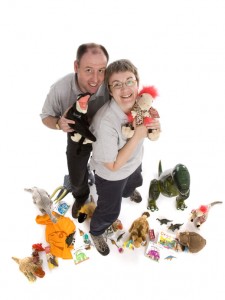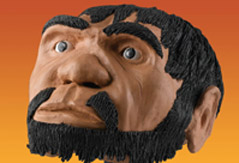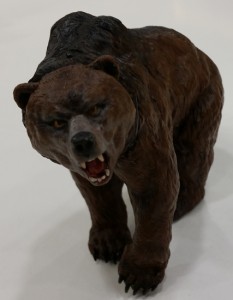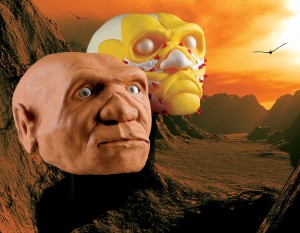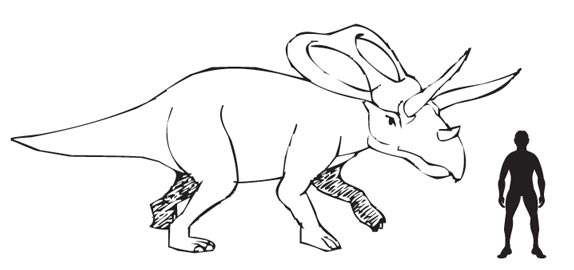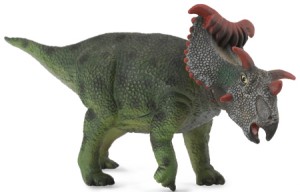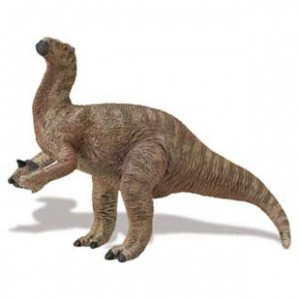The Dracorex “Dragon” on ITV Television series Primeval
A bone-headed dinosaur (Dracorex) makes an appearance in the television series “Primeval”.
The highly successful television series “Primeval” is currently being transmitted in the UK on ITV1 at peak viewing time on Saturday evenings. This television adventure series about a unusual group of scientists and their mission to track down anomalies in the fabric of time and rescue prehistoric animals that wander through into the present, is one of the most popular programmes on the networks. It attracts something like 6 million viewers each Saturday night. Created by the team behind the “Walking with Dinosaurs” franchise, state of the art special effects are used to recreate a vast array of prehistoric animals from Permian predators, to Pterosaurs and of course, everyone’s favourites – Dinosaurs! However, television appearances can be deceptive, take for example the depiction of Dracorex.
In this evening’s episode (screened on May 9th in the United Kingdom), the plot revolves around the team’s attempt to rescue a knight and a “dragon” that have gone through a time anomaly in the Middle Ages and ended up in the middle of 21st Century London. Presumably, the “dragon” had gone through a hole in space and time from the Mesozoic to the Medieval age and then a brave knight was despatched to slay the beast, unfortunately for both combatants they seem to have fallen through a second anomaly and found themselves in the present day.
Primeval
This is the cue for numerous chase scenes and high jinks as our heroic team of adventurers try to capture the beast and persuade the knight to return to his own world, hopefully without the slaying of a few innocent bystanders. Of course, we accept that this is all hokem, a bit of harmless fun, good wholesome family entertainment on a Saturday night. After all, we must have something to watch now that Doctor Who is no longer on the box.
However, the “dragon” in this episode is based on a real dinosaur, an animal that was only named and described a few years ago. That dinosaur is Dracorex hogwartsia, the name literally means “Dragon King of Hogwarts”. It is a type of pachycephalosaur, otherwise known as a “bone head”, a remarkable group of dinosaurs with heavily reinforced brain cases, which in larger genera could be up to 20 cm thick. Most of what scientists know about pachycephalosaurids is based on a number of well-preserved skulls that have been found. There have been very few fossilised skeletons of this bizarre group of dinosaurs discovered to date. Becoming quite prominent in the Maastrichtian faunal stage (the very end of the Cretaceous), this group of dinosaurs, related to the horned dinosaurs, was one of the last to evolve. They began as small-sized animals, perhaps no bigger than a domestic cat, some with a slight thickening of the skull. By the very end of the Cretaceous they had become quite large and the skull ornamentation developed to spectacular proportions.
Dracorex
Dracorex certainly resembled a dragon, so it makes a good stand-in for the beast of mythology. However, fire breathing was not in this dinosaur’s repertoire (as far as we can tell from the fossil record), and, like all the other pachycephalosaurs it was herbivorous, (although recen research suggests that some of these dinosaurs could have been omnivores. It had a long snout for a pachycephalosaur and rows of bumps and spikes across its nose and around the rear edges of its skull. It lacks the characteristic dome-shaped skull and scientists believe that Dracorex lost this ancient trait of the pachycephalosaur family, evolving secondary skull characteristics, more associated with earlier types of primitive pachycephalosaur.
An Drawing of the Dinosaur Known as Dracorex
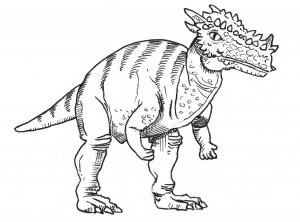
An illustration of the “bone headed” dinosaur called Dracorex.
Picture credit: Everything Dinosaur
The name Dracorex hogwartsia “Dragon King of Hogwarts”, honours J. K. Rowling the author of the famous Harry Potter books. This animal’s superficial resemblance to a dragon, coupled with the reaction of school children when the skull was first put on display inspired the scientists to name this new dinosaur after the fictional school in the Harry Potter novels.
When creating a realistic model for this particular dinosaur, the designers were faced with two major problems. Firstly, in the absence of most of the body fossils of this particular animal, no one was really sure what this dinosaur looked like. Secondly, the size and stature of this dinosaur was unknown. To overcome the first problem, the design team resorted to the tried and trusted method used by palaeontologists the world over to depict pachycephalosaurs. They based the reconstruction and prototype moulds on another similar dinosaur called Stegoceras – the best known of all the pachycephalosaurids.
Estimating size and working out the stature of this dinosaur, proved to be just as tricky. Using the skull it has been estimated that this bipedal animal was probably no more than 3 – 4 metres in length. Hardly making it dragon sized. As to the stature and stance of this dinosaur, this is very much open to conjecture. Bob Bakker, the palaeontologist who formerly named and described Dracorex in 2006 provided various estimates to the weight of Dracorex. Perhaps it weighed as little as 50 kilogrammes and was a fast running, light and agile creature – a good strategy since it shared its environment with Tyrannosaurus rex. An alternative view is that it was a heavy set animal with a large gut, a prerequisite when it comes to digesting plant material and this dinosaur could have weighed as much as a horse.
A Pachycephalosaurus wyomingensis Skull Replica on Display
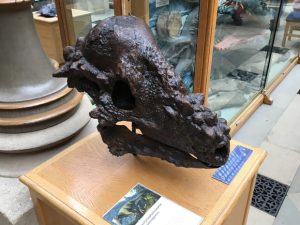
Pachycephalosaurus wyomingensis replica skull.
Picture credit: Everything Dinosaur
Dracorex Dinosaur Models
When it came to the model Dracorex, part of the Procon/CollectA range it was decided to depict this animal as a heavy set beast with a large tummy. This was not the designer’s way of demonstrating their support for one particular scientific hypothesis over another. There were more practical considerations. A heavy model with a fat gut would have a low and central point of balance, making the cast, plastic models much more stable on their two feet. In this case practical considerations related to the model making process were given precedence over the limited fossil evidence – a squat Dracorex was the result.
To view the model that resulted, the only model of a Dracorex in a mainstream, pocket money priced range as far as we know, visit the Everything Dinosaur website and judge for yourselves whether the Dracorex model bears any resemblance to the animal portrayed in tonight’s episode of Primeval.
To view the range of not-to-scale CollectA models and figures: CollectA Age of Dinosaurs Prehistoric Life.
When we first viewed this particular model we described it as “dumpy” and this nick-name stuck and a number of our team members at Everything Dinosaur, now refer to D. hogwartsia as “dumpy”. Having never seen one in the flesh, and with only limited fossil evidence to go on, it is not a bad effort all things considered. After all, if we are prepared to watch a television programme about Late Cretaceous pachycephalosaurs and Medieval knights roaming around London who are we to criticise when it comes to using a little creative flair and imagination to make a model dinosaur.
Dracorex is one of approximately 30 prehistoric animals in the Procon/CollectA series. We were involved with the very first sculpts, I remember advising on the Brachiosaurus all those years ago. The range has grown rapidly and many more models are to be added including other prehistoric animals, not just dinosaurs.
To visit the award-winning Everything Dinosaur website to view the range of dinosaur toys and gifts available: Visit Everything Dinosaur.







